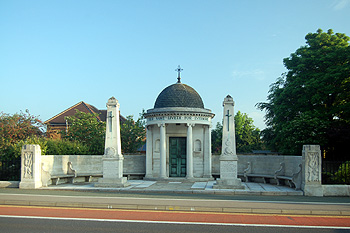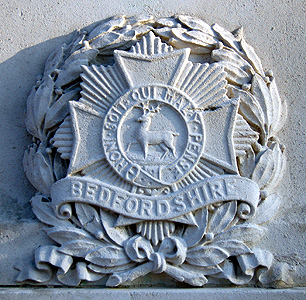The Bedfordshire Regiment War Memorial

The Bedfordshire and Hertfordshire war memorial May 2012
The war memorial to the men who died whilst serving with the Bedfordshire Regiment during World War One was built in 1920 and unveiled in 1921 opposite Kempston Barracks. The memorial was listed by English Heritage in 1984 as Grade II, of special interest.
In March 1921 the site for the memorial was conveyed free from James Harold Howard of Kempston Grange, who had lost his own son Addison whilst serving with the 1st Battalion, Bedfordshire Regiment on the Somme in 1916, to trustees of the Regimental Association – Major General Thomas David Pilcher, Brigadier Charles Richard Jebb Griffith and Colonel Thomas Hammond. The site contains four poles of land [WW1/RH5/2].

Bedfordshire Regiment badge May 2012
An appeal for funds was undertaken and a leaflet circulated [WW1/RH5/4] based on an article in The Bedfordshire Times of 7th January 1921: “The design of the proposed Regimental War Memorial of the Bedfordshire and Hertfordshire Regiment [renamed on 1st August 1919] … is a matter of deep interest to all our readers, for there is hardly anybody in the county who has not had some personal association with the County Regiment, while all have the right to share the pride in its glorious conduct during the war. The design, which has now been definitely approved, is the work of Mr. George P. Allen, F. R. I. B. A., of Bedford, who has deservedly won a considerable reputation for his work. Mr. Allen has made a special study of war memorials”.
“It is proposed to erect this Memorial opposite to the gates of the Kempston Barracks. The Headquarters of the Bedfordshire and Hertfordshire Regiment. The object in selecting this site is two-fold, namely that the regiment may be able to keep watch over the Memorial, and that the ordinary passer-by may for all time associate it with “The Bedfords” of his own generation. It is hoped that in this way the ties between the County and the County Regiment [disbanded in 1958] will always be of that close nature which is desirable from the point of view of good citizenship and patriotism”.
“The Regiment are fortunate in having received the site for the Memorial as a free gift from Mr. and Mrs. Harold Howard of Kempston Grange, to whom the land belongs. The generosity of this gift will be appreciated by all who know the situation, and it will receive a sympathetic recollection of the fact that Lieutenant Addison Howard, the only son of Mr. and Mrs. Harold Howard was one of the soldiers who fell fighting in the ranks of the Regiment”.
“The Mayor and Corporation of Bedford have certain rights over the land, which they have been good enough to waive”.
“It will be seen that the form which the Memorial is to take is that of a small shrine in a semi-circular paved enclosure, which will be flanked by stone benches. The object in having this little shrine is that there may be some place in which the names of all those who had ever served in any Battalion of the Regiment and were killed in action or died of wounds or disease in the Great War may be recorded. As these names, alas, run to some thousands [6,081] it would be impossible to record them on any monument or wall-space in such a manner that they could be conveniently read. It is proposed, therefore, to record all the names on parchment sheets in an illuminated book or scroll which will be kept in a glass case within the little shrine and will be accessible to anybody who desires to see it. The key of the shrine will be kept in the Guard Room at the Barracks, and the Guard will have standing orders to open the door of the shrine for anybody who comes with that request. It is certain that on “Remembrance Day” and possibly other anniversaries, it will become a regular practice for people to visit the Memorial, turn over the leaves of the “Roll of Honour” and leave floral offerings at the base of the stone pillar in front of the enclosure. It will be noticed that the shrine itself is surmounted by a Cross as the emblem of sacrifice and the entablature will bear the inscription: “Their name liveth for evermore”. The interior will be lighted with stained glass windows”.
“The progress of the Memorial will be made clear for all time by an inscription on the stone pillar or obelisk, which will stand in front of the paved enclosure and will be as follows: -
To the Sacred and Glorious Memory
of the
Soldiers of the Bedfordshire Regiment
Who fell in the Great War
This Monument has been erected by their
Comrades of the Regiment
The other three sides of the pillar will be engraved with the names of the battles and Fields of Operations in which the several Battalions of the Regiment were engaged, and also with a record of the actual number of officers and other ranks who fell in the Great War”.

Panel on the Bedfordshire Regiment war memorial May 2012
“It is hoped to raise a sufficient sum of money not only to meet the cost of this monument, but also to provide for two other objects which form part of the War Memorial scheme”.
“One of these is a Battle Picture emblematical of the spirit of the Regiment which could be reproduced in prints and lithographs, which in time to come would no doubt be found in many houses and even in the humblest abode”.
“The third object is that any surplus funds should be devoted in the establishment of a Benevolent Fund for the assistance of hard cases which do not come within the scope of the existing schemes of public and private benevolence”.
“It will be seen that this Memorial concerns the county as a whole, and equally the neighbouring counties of Hertfordshire, Huntingdonshire and Buckinghamshire, which sent so many men into the Regiment. The numerous local memorials which have been erected cannot take the place of a memorial to the heroes of the Regiment as a whole. It should also be remembered that many officers and men who fell fighting in the ranks of the Bedfords were not men of this county or a neighbouring county, so that their names will not be recorded on any village memorial. The memory of such gallant comrades who identified themselves wholly with the Bedfordshire Regiment, and all that it stands for while they served in its ranks and until they fell upon the field of honour, should be preserved. It is particularly on this account that it is essential to have a single Regimental memorial, and it will be for the undoubted advantage of the people of Bedfordshire, Hertfordshire, Huntingdonshire and Buckinghamshire in time to come that such a Memorial should exist”.
“The sacrifice of those who died that we might live will have been in vain unless we keep their names and their deeds in perpetual remembrance as an example of noble patriotism and as an incentive to that good citizenship on which the honour and welfare of our country will ever depend”.
The memorial was unveiled on 11th November 1921 by the wife of Samuel Howard Whitbread, the Lord Lieutenant for Bedfordshire. The memorial was consecrated by Michael Furse, the Bishop of Saint Albans [WW1/RH5/7].
The memorial is built of Portland Stone, the same material used for the headstones in all Commonwealth War Graves cemeteries. It has a slate roof. The obelisk, referred to above, was joined by another in 1950 to commemorate the 1,074 men who died serving with the Bedfordshire and Hertfordshire Regiment in World War Two. Behind the memorial is a small garden of remembrance where the ashes of forty four people connected with the regiment have been scattered over the years.

Bedfordshire and Hertfordshire Regiment badge May 2012